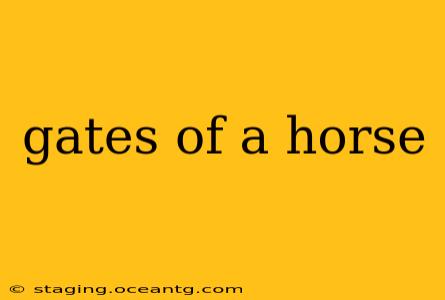Horses, majestic creatures of power and grace, exhibit a fascinating variety of gaits, or ways of moving. Understanding these different gates is crucial for horse owners, riders, and anyone interested in equine locomotion. This article delves into the specifics of various horse gates, addressing common questions and providing detailed explanations.
What are the different gaits of a horse?
Horses possess a range of natural gaits, each characterized by distinct leg movements and speeds. The most common are:
-
Walk: This is the slowest gait, a four-beat movement where each foot hits the ground separately. It's a smooth, comfortable gait ideal for leisurely rides or groundwork.
-
Trot: A two-beat gait with a diagonal pair of legs moving together. It's faster than a walk and provides a bouncy ride.
-
Canter/Lope: A three-beat gait with a period of suspension where all four feet are off the ground. The canter is a smoother, more collected gait, while the lope is often described as a more extended and free-flowing version. The difference is subtle and often depends on the discipline.
-
Gallop: The fastest gait, a four-beat movement with a distinct period of suspension where all four feet leave the ground simultaneously. It's characterized by powerful strides and significant speed.
Beyond these basic gaits, some horses naturally display other movements, including:
-
Pace: A two-beat gait where the legs on the same side move together. This is more common in certain breeds like Paso Finos and Tennessee Walking Horses.
-
Rack: A four-beat gait unique to certain breeds like Tennessee Walking Horses, characterized by an elevated, high-stepping action.
What is the difference between a walk, trot, canter, and gallop?
The key differences lie in the rhythm, number of beats, and speed:
- Walk (four-beat): Slowest, each foot strikes the ground individually.
- Trot (two-beat): Moderate speed, diagonal pairs of legs move in unison.
- Canter/Lope (three-beat): Faster than a trot, three beats with a period of suspension.
- Gallop (four-beat): Fastest, four beats with a longer period of suspension.
The easiest way to distinguish these gaits is to count the beats of the horse's hooves hitting the ground.
How can I tell the difference between a canter and a gallop?
The main difference lies in the speed and the length of the suspension phase. A canter has a shorter, less pronounced suspension, while a gallop features a longer, more noticeable suspension where all four feet are off the ground. The canter is often described as a more collected gait, while the gallop is typically more extended and powerful.
Why do horses have different gaits?
Horses evolved with multiple gaits to adapt to various terrains and situations. Different gaits allow horses to optimize speed, efficiency, and comfort depending on the conditions and their needs. For example, the walk is suitable for navigating challenging terrain, while the gallop is best for escaping predators or covering long distances quickly.
What are some common gait problems in horses?
Various issues can affect a horse's gaits. These include lameness (pain in the legs or feet), muscle imbalances, and neurological disorders. These problems can manifest as uneven strides, reluctance to move, or changes in the natural rhythm of their gaits. Any significant change in a horse's gait should be evaluated by a veterinarian.
Conclusion
Understanding a horse's gaits is essential for anyone who interacts with these incredible animals. By recognizing the differences between the various gates and paying attention to any deviations from the norm, you can help ensure the well-being and performance of your equine partner. This knowledge, combined with observation and potentially professional veterinary advice, allows for a deeper appreciation and understanding of horse movement and health.
